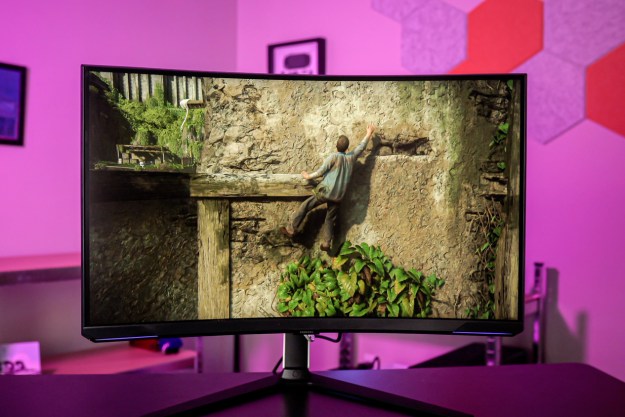The Lenovo Legion Go is impressive. That’s not necessarily a good thing, but it certainly leaves an impression. As you can read in our Lenovo Legion Go review, its massive screen and unique features stand out among other handheld gaming PCs. But in my testing, it shows some strange issues compared to the similarly priced Asus ROG Ally.
The Legion Go and ROG Ally are very similar devices, packing similar specs and pricing, and both running Windows 11. They’re among the most powerful handheld gaming PCs on the market right now, but the Legion Go clearly needs some more tuning with its performance before it’s ready for your dollars.
Pricing and availability

Both the ROG Ally and Legion Go are available in two versions, but Lenovo and Asus approach these versions in different ways. Starting with the ROG Ally, the base model (and the one we’re using for comparison here) is $700, and it comes with 512GB of storage and the AMD Ryzen Z1 Extreme. Asus also sells a version with the AMD Ryzen Z1 processor for $600, which otherwise has identical specs.
The Legion Go comes with the AMD Ryzen Z1 Extreme regardless of the version you choose. The base model comes with 512GB of storage for $700, just like the ROG Ally. However, Lenovo also offers a version with 1TB of storage for $750. The extra storage is nice, but both the Legion Go and ROG Ally allow you to replace the SSD if you don’t mind getting your hands dirty.
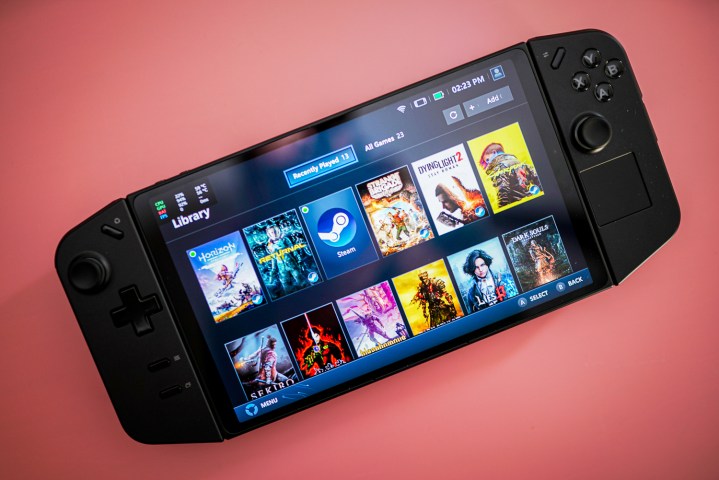
The ROG Ally is technically cheaper if you’re just worried about saving money. As you can read in our review of the ROG Ally Ryzen Z1, though, that handheld sacrifices way too much performance to achieve its $600 price tag. For the sake of comparison, the ROG Ally and Legion Go are the same price, with the Legion Go offering a slightly more expensive version for a fair upgrade to storage.
There’s no clear winner here, but the Legion Go has a slight edge. It comes with the same hardware as the ROG Ally, but a much nicer display and additional features like first-person shooter (FPS) mode that allows you to detach a controller and use it like a mouse. The edge is only slight, though. As I’ll dig into throughout the rest of the comparison, the Legion Go makes plenty of trade-offs.
Display

Undoubtedly the most impressive aspect of the Legion Go is its screen. It’s a 1600p display with a 165Hz refresh rate, but it’s not those specs that matter. It’s that you’re getting an 8.8-inch display on the Legion Go, whereas the ROG Ally is limited to a 7-inch screen. That extra size makes a massive difference.
Consequently, it also makes the Legion Go massive. It’s much bigger than the ROG Ally, and much heavier as well. With the controllers attached, the Legion Go is 856 grams, which is super heavy compared to the 608 grams that the ROG Ally weighs.
The ROG Ally achieves its smaller size with a less impressive screen. It’s a 1080p display with a 120Hz refresh rate, and as mentioned, it’s only 7 inches diagonally. It’s much less impressive than the Legion Go’s display, and it’s even beaten by the Steam Deck now that the Steam Deck OLED is available.

Although the Legion Go’s screen is more impressive on paper, it’s a bit of a hassle in practice. The higher resolution and refresh rate means that the battery drains about as fast as the ROG Ally’s, despite the fact that Lenovo packs in a larger battery. The biggest problem is performance, though.
You can’t play most games at the native 1600p resolution with the Ryzen Z1 Extreme, at least not without sacrificing a lot of performance. That means you’ll often be running games below 1600p, which is particularly noticeable on such a large screen. It’s strange that Lenovo chose such a high resolution, as you often won’t achieve it unless you restrict yourself to a low frame rate or 2D games.
The ROG Ally has a similar problem with its 1080p screen, but it’s less pronounced. Not only are games more likely to achieve playable frame rates at 1080p, the smaller size of the screen hides the imperfections if you need to bump down the resolution.
The Legion Go certainly has a more impressive screen, but in real use, the ROG Ally’s more conservative approach comes out on top.
Performance
Performance is strange for the Legion Go. As mentioned, it’s packing the same Ryzen Z1 Extreme as the ROG Ally, so the two devices should have largely similar performance. That’s not the case at all.
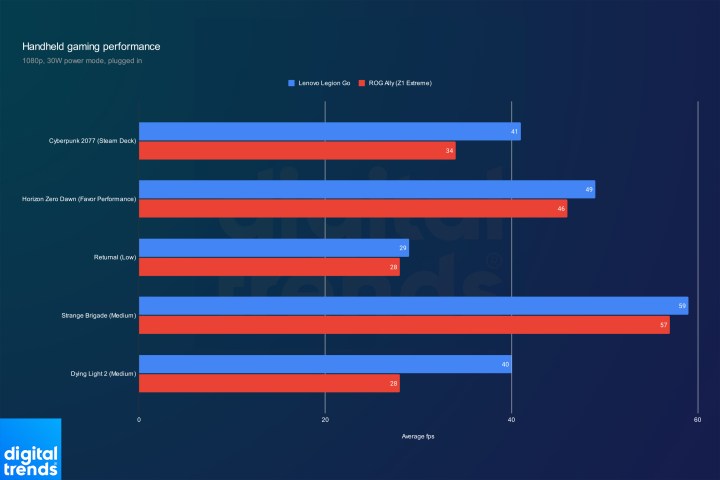
Locking both devices to 1080p and running at the maximum power mode, you can see the Legion Go breeze ahead of the ROG Ally with ease. It has a win in every game we tested, with some titles like Dying Light 2 showing massive differences. That’s what a larger device affords you. The Legion Go seems to handle the heat better when the devices are pushed.
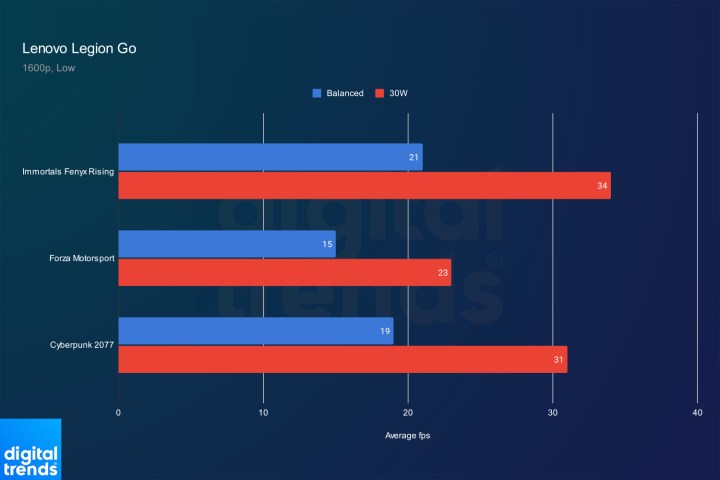
Jumping up to the native 1600p resolution for the Legion Go exposes some of the strange performance, though. It can crack 30 frames per second (fps) in titles like Cyberpunk 2077 and Immortals Fenyx Rising, but only with the device plugged in on its highest power mode. You’re sacrificing around 30% to 40% of the performance if you unplug the charger and use the 15-watt Balanced preset.
That’s not the worst of it. If we limit the device to 800p for a fair comparison to the Steam Deck OLED and ROG Ally, you can see the Legion Go is massively behind in every game we tested. It’s even beat by the Steam Deck OLED, which has a much weaker processor on paper.
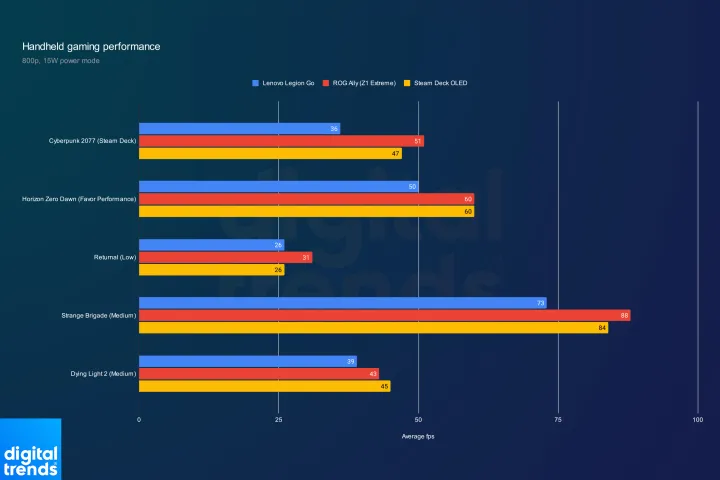
What’s going on here? It seems Lenovo still has some tuning to do on the Legion Go. It’s a blisteringly fast device with the power maxed out when it’s plugged into the charger, but it’s clear Lenovo isn’t getting the most performance out of the Ryzen Z1 Extreme at its more conservative power modes. That’s a problem for a handheld gaming device.
Both the ROG Ally and Legion Go suffer from poor battery life, but it hurts more on the Legion Go. Even at the Balanced mode, you’d be lucky to get two hours out of a demanding game like Cyberpunk 2077, and with the power maxed out, you’ll barely crack 45 minutes. Considering the Legion Go can only put up numbers with full power, it’s hard calling it a portable gaming PC at all.
The ROG Ally is a winner
The Legion Go could eventually become a go-to handheld gaming PC, but it has too many problems to recommend right now. The strange performance numbers combined with an awkward form factor outweigh any extra features it offers, and even its impressive 8.8-inch screen.
The ROG Ally isn’t perfect, either, with fierce competition from the Steam Deck. However, among the Windows handheld gaming PCs I’ve tested, it still remains the best option for gamers looking for peak power on the go.
Editors' Recommendations
- This Lenovo gaming PC has an RTX 4070, 32GB of RAM, and it’s $610 off
- Brighter isn’t better for OLED monitors. An expert told me the surprising reason why
- The best handheld gaming PCs you can buy
- ‘Compact Mode’ can’t fix the Xbox app. Here’s what could
- 23% of PC gamers probably can’t play Alan Wake 2. Here’s why



